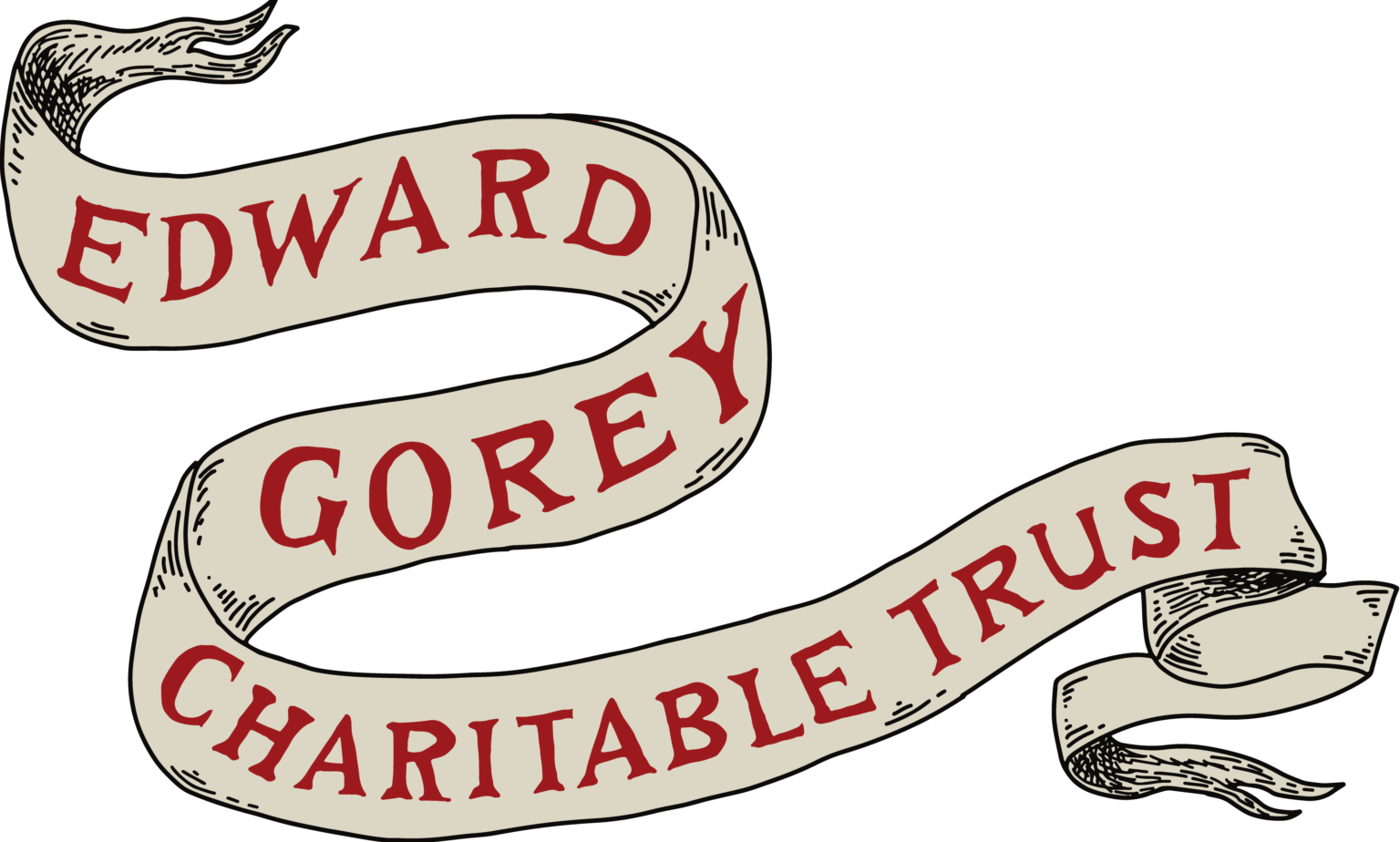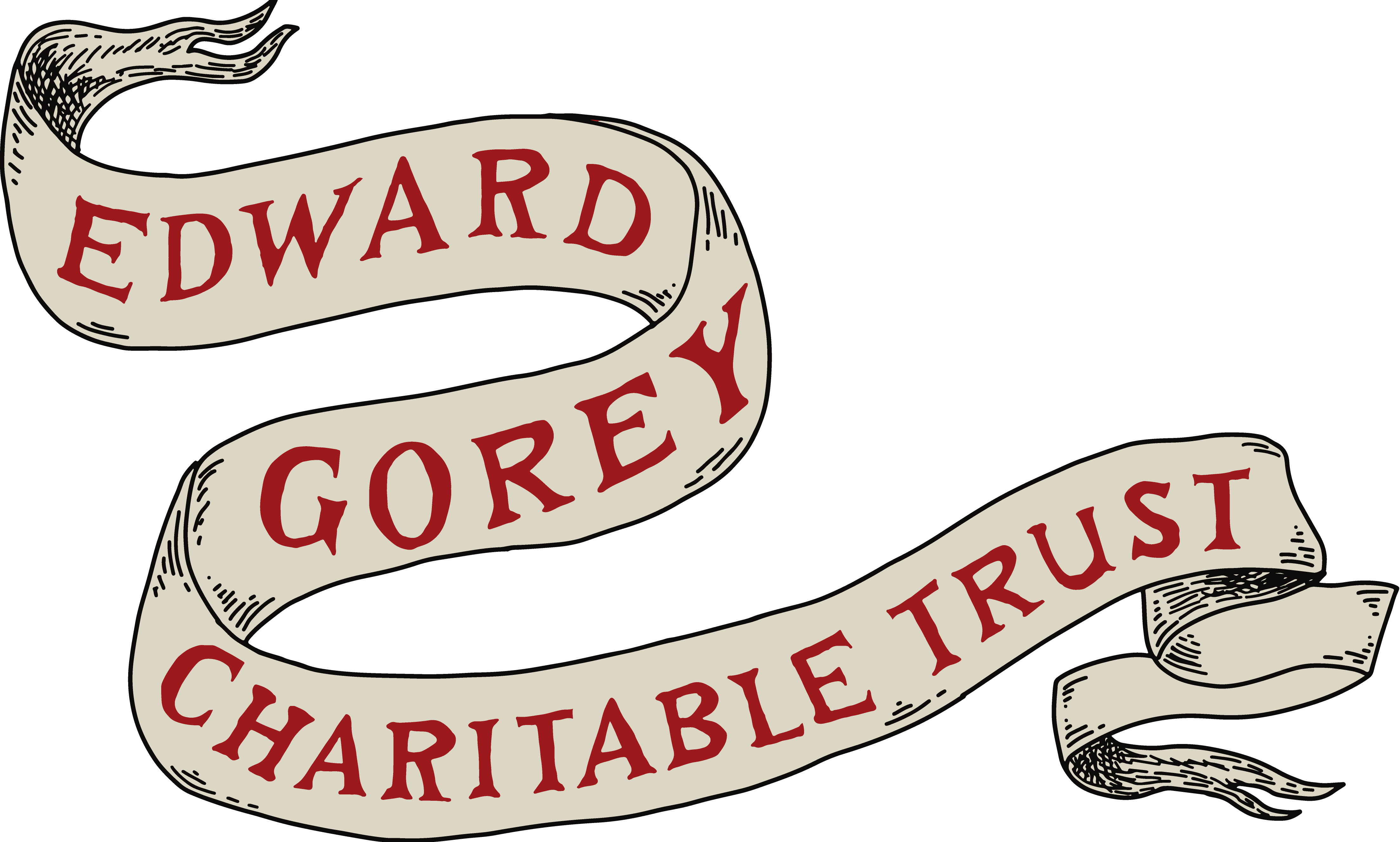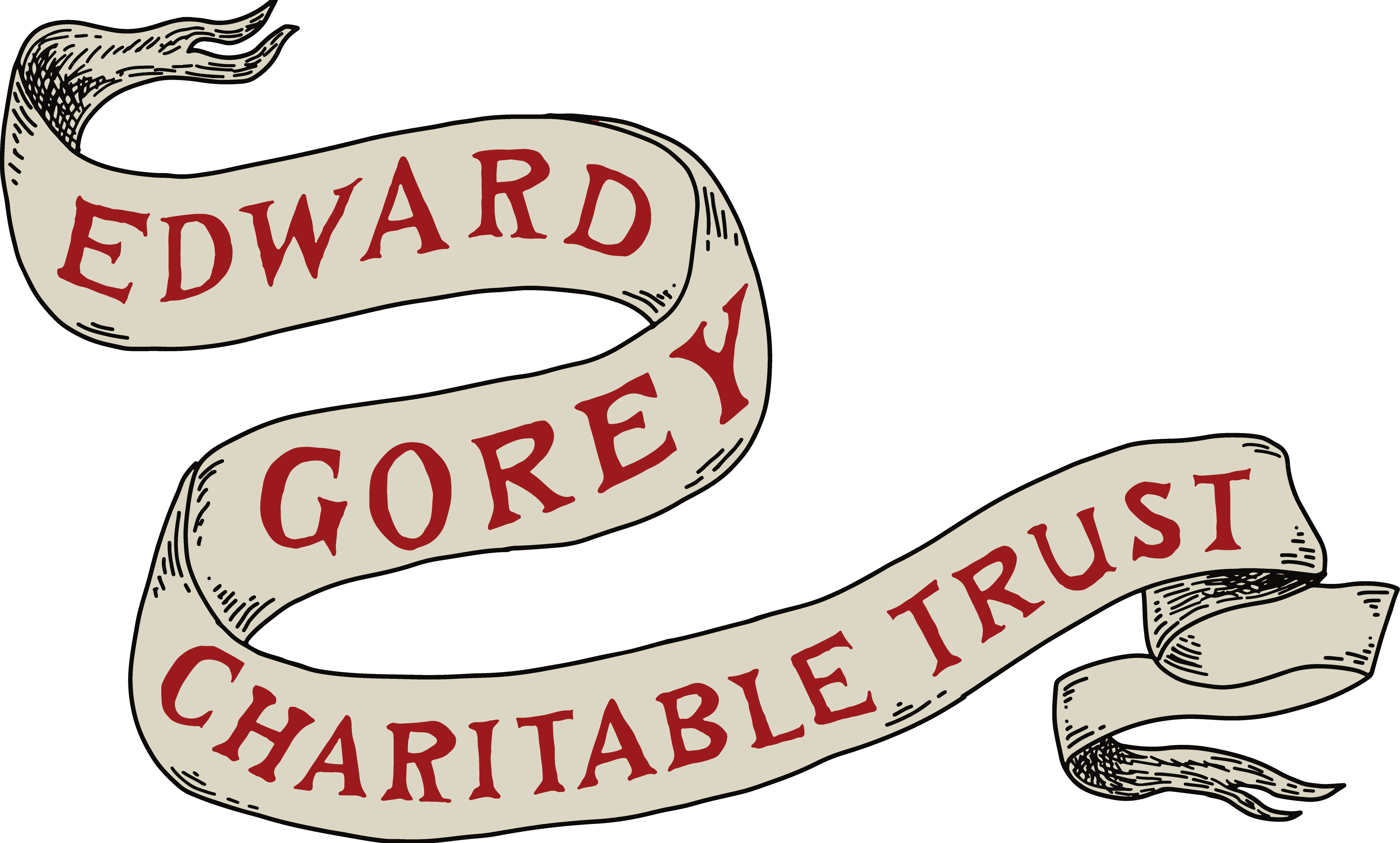By Malcolm Whyte
While browsing Mill Valley’s Capricorn Books in 1963, two scaly-winged creatures holding a portrait of a wan little girl lured me past its dolorous purple covers, into The Hapless Child by Edward Gorey. It was a thin paperback, but the drawings were densely drawn in pen and in the manner of the great print masters, Dore and Rembrandt. The minimal text told of the dire passage of Charlotte Sofia, from being orphaned and tortured at boarding school, followed by escapes, captures, and starvation too; finally blind, she collapses in a snowy roadway, where, her father, who was not dead after all, runs her over. He gets out, looks at careworn Charlotte Sophia, but does not recognize her, and drives away.
I couldn’t believe what I had just read. The story was so sad and the illustrations were executed with such arid formality I almost welled up. Almost. It then came to me: maybe the story is too pitiful; may it’s a parody, but then the drawings were no joke. Was the book a classic tragedy or a campy put-on? For sure, this was an author to follow. I bought this first edition of The Hapless Child, took it home, and hinted to my wife, Karen, “If you’re wondering what to give me for Christmas, it’s books by Edward Gorey.”
And so it came to pass that on certain holidays thereafter, I received small, colorfully wrapped packages hiding a Gorey book or two. Along the way, Karen and my daughter, Kirsty, discovered New York’s Gotham Book Mart (or as we called it “Gorey Central”), the premium source of signed Gorey items, and opened the door to many more treasures. As the book collection grew, so did my fascination for this amazing author/artist and I began adding his original art to it. Pen-and-ink drawings were first, then a water-color painting for a book cover, then in the middle 1980s, most of his graphic artworks — etchings, engravings, serigraphs, and collagraphs.
The License
Troubador Press was founded by Brady Harris and me, two recently discharged Naval officers, to design, print, and distribute greeting cards. Our first “office” was in the basement of a three-story red brick building at 96 Jessie Street, one block south of Market Street in San Francisco. In order to augment our meager cash flow from the card business, we took on producing books and magazines for others. Our best client was Lawrence Ferlinghetti and his City Lights publishing company. We did all the pre-press work for printing or reprinting City Lights’ books and broadsides like HOWL, Kerouac’s Book of Dreams, Bob Kaufman’s Does the Secret Mind Whisper, and Ferlinghetti’s own Pictures of the Gone World. We then brokered out the actual printing to job printers who had the presses big enough to handle book production.
At the end of 1962, Brady resumed his commission in the Navy and left for Long Beach. For the next decade, I continued to produce greeting cards but, taking what I learned from working with City Lights, published Troubador’s first book, The Fat Cat Coloring and Limerick book, in 1967. That worked out so well that I finally dropped the greeting cards as I added more coloring books, maze and game books, cookbooks, and art books to the line. As Troubador’s book business expanded, so, too, on the private front, did the Gorey collection, Troubador Press took a booth at the 1978 national book convention, in Los Angeles: Malcolm and Karen Whyte and two Troubador staff in attendance. I had just returned to the booth after a break when Karen handed me a crisp business card and said that a woman stopped by to inquire if Troubador would be interested in doing a book with Edward Gorey’s art. The business card announced Shirley Henschel, licensing agent, dba Alaska Momma.
I was so excited I stuttered, “what else, what else…?! Karen calmly replied,” She said she’ll be right back.” Moments later, there she was: a sturdy five and a half feet; brown hair stylishly cut; sincere dress; firm handshake; and gentle smile. She told us how the well-designed and illustrated Troubador books had caught her eye. “How can we fit Gorey into your publishing plans?” she asked. Karen had already told Shirley about our strong personal interest in Gorey and, unable to quell my enthusiasm about the prospect, I immediately suggested a few ideas, particularly one involving Larry Evans as I waved at his stunning 3-D mazes, hidden picture books, and monster illustrations prominently displayed in the booth.
With Evans’ and Gorey’s permissions, a licensing contract was made melding the former’s puzzle-smithing with the latter’s miraculous art, and Gorey Games was launched in the spring, of 1979. An unusually positive response to the book from the sales force encouraged me to take a chance on a 30,000 print run. Book of the Month Club added an additional 5000 copies for young subscribers to their Quality Paperback Book division.
At the reprinting of another 10,000 copies of Gorey Games, Troubador ran the guts for a hardcover edition limited to seven-hundred-fifty copies with a previously unpublished Gorey drawing bound in1979 catalog cover. In 1981 I contacted Shirley Henschel with a proposal for a book of Gorey cats paper dolls. He would not have to draw anything. We would reconstruct the cats and their outfits from the dazzling variety of cats he drew for the end pages of Workman Press’s Cat Catalog. Shirley reported that Gorey said, “I don’t understand it, but go ahead.” So, from my concept, Troubador art director, Nancie Swanberg subtly repositioned the arms and stances of four cute cats to fit dozens of costumes, among them an opera supernumerary, a classic orator, a garland dancer, a Japanese emperor, and a snappy dresser with an ankle length fur coat much like Gorey wore.
The fold-out back cover, in addition to having three of the cat dolls to cut out, became a backdrop for changeable, ready-to-color scenes on pages in the book. To round out the play-value of the book, I included cut-out-and-stand-up models of Gorey’s Fantod, Osbick bird, and the Doubtful Guest. Gorey Cats Paper Dolls was published in spring, of 1982.
I was very proud to have published these two books with Edward Gorey’s fabulous art. As we’ll see, they opened the door to other connections with him.


Early Exhibitions
Late Friday afternoon, the day before New Year’s Eve, 1982, I sold Troubador Press to Price Stern Sloan of Los Angeles and continued to produce an average of four books a year books as Editorial Director of Troubador until 1996. At the same time, I reincorporated and opened a new office as Word Play, Inc. at One Sutter Street, San Francisco. Not having to run a company full time allowed me to realize a project ambling about in my mind for a long time — a cartoon art museum (yes, in addition to works by Gorey, I collected original cartoon art).
After obtaining a non-profit 501c3 status, several fellow cartoon art collectors joined me in founding San Francisco’s Cartoon Art Museum (CAM) in 1984. We formed a board of directors, worked out a five-year plan, began a campaign for subscribing members, and searched for venues for an exhibition. Soon we were offered our first exhibition. Pooling our best pieces, we submitted two-dozen originals to be installed in wall cases on a well-traveled corridor at San Francisco’s International Airport. We were overjoyed!
We soon learned that some places paid a loan fee for an exhibition, and that became the first of many sources we developed to sustain the CAM. As of this writing, it is celebrating its thirty-eighth year of operation.
Artist of Mystery
Gorey’s characters’ opening to PBS’s Mystery! (cleverly animated by Derek Lamb) was gleefully welcomed in 1980 and has entertained — and introduced Gorey to — hundreds of millions of fans ever since. Recognizing that, in 1993, I proposed a major exhibition to CAM’s board titled “Artist of Mystery, Original Works by Edward Gorey.” Because the museum did not have enough material in its own collection to represent a single artist or theme, most of its exhibitions had to borrow art from other sources; often several lenders were involved. I told the board that the items for the exhibition would all come from my collection, so there was no expense in obtaining permission, shipping the art, or buying complicated insurance. I’d also write, design, and produce a small catalog. The board of directors enthusiastically authorized the exhibition.
Driving the art from my home in Mill Valley to the City was a chinch. It was the catalog that caught me up; not because of the production of it, but having to make a call to Edward Gorey to make it right. I considered him to be a celebrity and that inhabited me. Maybe introducing myself as the publisher of Gorey Games would make my interrupting the famous, busy, artist more tolerable.
The conversion was slow and cool in the beginning. After Gorey said “hello” a long pause lingered before my nerve let me make my introduction, to which Gorey responded, “yes?” He remained taciturn while I rattled on about the Cartoon Art Museum’s extensive exhibition of his original paintings, drawings, and limited-edition prints. “We’ll also be publishing a small catalog for the event, and may we send you a number of them to sign that the museum could sell? Of course, we’d pay for shipping both ways,” I added nervously. A pause again, then indicative of his unreserved generosity, he agreed to do as asked and the mood brightened measurably.
Near the end, I asked Gorey if he would be coming to San Francisco for the exhibition. To his very firm “no!” I impulsively blurted, “Oh, poo!” at which he laughed out loud. Relieved, I felt we had just established a friendly connection. The Artist of Mystery catalog, was a slim, near-square, eight-and-a-half-inches by seven-inch booklet comprising short introductions to Gorey; his books, and his art; several illustrations from the exhibited works; and a complete listing of the fifty-nine items, many of which had not been seen before by the public. The catalog had a print run limited to five-hundred and twenty-six copies. As promised, of those, one hundred were signed and numbered and twenty-six were signed and lettered by Gorey. The unsigned and the numbered catalogs were wrapped in stylish olive color, priced at three-dollars-fifty and ten dollars, respectively. The twenty-six lettered, twenty-dollar editions came with a very light grey cover. If found on the internet now, they’d cost more.

Goreyography
Rare bookseller and devoted collector of Gorey’s books, Henry Toledano, was among the unprecedented crowds who attended Artist of Mystery. I was introduced to Toledano as a publisher as well as curator of the exhibition, at which he mentioned that he was compiling a list of Gorey’s books for a project similar to his self-published price guide to Modern Library books. When he suggested that he might consider someone else to publish his Gorey manuscript, my antennae shot up. I had to publish Toledano’s book! Gorey collectors were increasing in number rapidly and desperately needed a bibliography to help navigate their search.
By the nineteen-nineties Gorey had written and illustrated one hundred books of his own. They were published in paperback, hardcover, numbered, lettered, and foreign editions. Illustrated articles about Gorey swelled collector’s files. It was a mind-boggling job to sort all this out, but Toledano was determined to do it. Throughout 1994 and 1995, each time we conferred, Toledano had added more data: titles and dates of dramatic production of Edward Gorey, then sound recordings, then major exhibitions of his works.
On January 22, 1996, Toledano sent me a complete general outline of his book. At that point, I convinced him that he would be financially better on a royalty arrangement, while Word Play shouldered all production, promotion, sales, warehousing, shipping, billing, and coordinating art reproduction permissions with Gorey and Andreas Brown, Gorey’s estate co-trustee and owner of the Gotham Book Mart in New York.
On February first, Toledano elected Word Play to publish his book. I christened it Goreyography, combining “Gorey” with “bibliography.” Collector Jim Weiland volunteered to contribute a chapter on Gorey printed ephemera and the countless items that carried Gorey’s distinctive imagery. I provided a chapter called “The Artist’s Hand” that briefly described Gorey’s original drawings, paintings, and art prints, and where to find them.
Now, I just had to call Gorey again for certain favors regarding the book.
Any confidence I had gained from my last call had drained away during the last three years. Nevertheless, I rang Gorey’s Cape Cod home to receive a slightly perturbed, “hello.” Taking a big breath, I re-introduced myself, referring to our two books “together” and the exhibition of his books and art at the Cartoon Art Museum. Calming down a bit, I described the proposed bibliography, stressing its importance to the book world in general. He had already heard about it from Andreas Brown, “but go on,” After one more deep breath, I plunged in somewhat as follows.
“My we reproduce about a dozen of your already published images for the book?”
“Yes,” he said softly, “use anything you want.”
Confidence regaining. “Do you have an unpublished image we could use for the book’s front cover?”
Another beat of silence. Then with a classic Gorey sigh, he said, “Oh, I suppose I’ll have to draw something for you.”
The receiver almost flew from my hand! “Omigod…that’d be fantastic…thank you…thank you!” I crocked.
Recovering from my elation, I shamelessly unleashed a final request: would he please sign, number, and letter limited editions of the book? I quickly traced the four-way relay that the limitation pages would take (prepaid by Word Play): printed in Michigan; sent to Gorey for signing; forwarded from him to Word Play for adding signatures by Toledano, Weiland, and Whyte; and finally mailed back to Michigan to be bound into the book. I also told Gorey he would receive two copies of each format, plus three numbered copies for his archives.
“Is this all OK with you, and if so, how could we compensate you?
“Yes, of course, I’ll do that” he said. “but please, let’s not worry about that [payment] now.” We chatted a bit about his current projects. I heartily thanked him again for his unstinting generosity and told him I’d send him a letter restating our conversation and our sincere appreciation for his selfless cooperation.
Almost everything was now in place to make Goreyography. Only two elements had to be in hand: the completed manuscript and Gorey’s art. Jim Weiland’s vast collection gave Toledano access to much more information than he had already gleaned. Toledano’s concept for Goreyography as a price guide/checklist began to change as soon as he went through Weiland’s treasures. Entries got more comprehensive as the points differentiating various editions piled up. Arguments about evaluating Gorey’s books ensued. Slightly built, sexagenarian Toledano would dig his heels in on a point. Towering over him, barrel-chested Weiland would try gentle persuasion until agreement was reached.

Tension — and opportunity — rose when Andreas Brown entered the ring. Besides beings a long-time friend, publisher, and promoter of Gorey’s work, as well as and co-trustee of his archives, Brown was a trained bibliographer. He was aghast at Toledano’s scant cataloging of Gorey’s output. Consequently, he volunteered to review the emerging manuscript, the result of which was my receiving daily, single-spaced typed pages (sometimes two or three at a time) brimming with helpful comments, additions, and corrections, all of which coaxed Goreyography into becoming a much more useful document than originally conceived.
Like the professional he was, Gorey got his art to Word Play before the end of April 1996. The return address on the FedEx package read: Edward Gorey, 8 Strawberry Lane, Yarmouth Port, MA 02675 (now the historic site of the Edward Gorey House museum). I had no idea what of what the images would be; I just knew they’d be wonderful. Out of the envelope slid an eight-inch by five-and-a-half-inch black and white drawing of four Figbash figures cavorting around the word “Goreyography” in Celtic-like calligraphy that referred to Gorey’s Irish heritage. Celtic knots extended from the Figbash’s hands and were drawn on their bellies. “By Henry Toledano” was also hand-lettered by Gorey for the book cover and spine.
A smaller drawing dropped out of the package. On a three-inch square card three inked Figbashes, fingers touching, rotated in a triangular dance: a perfect image for the book’s title page and back cover. On April twenty-fifth I sent Gorey an ardent note of appreciation and a check for his superb drawings.
Miraculously, mid-November Word Play received bound Goreyographys in less than six weeks since its typescript and art had been sent to the printer. The cartons were neatly separated and labeled: paperback, hardcover trade edition, hardcover signed and numbered, etc. Goreyography was ready to begin its career as the “go-to” book for scholars and collectors of Gorey’s creations; a career as his sole bibliography for twenty-six years as of this writing. Goreyography’s unique position eventually may be overshadowed by a complete, paginated bibliology by Gorey collector and bibliographer, Edward Bradford; publication is in the works, although a release date is not yet set.
Later Exhibitions

Gorey World
To coincide with the publication of Goreyography, I proposed to the Cartoon Art Museum another, even bigger exhibition of Goreyana than the one in 1993. Our “Gorey World” would be the most complete representation of Gorey’s oeuvre ever seen by the public. Contributions from my and Jim Weildand’s collection constituted the bulk of the ninety items on exhibit, but, of special note, the Gorey archives loaned the museum two original drawings from The Willowdale Handcar; two from The Remembered Visit; two completed pages, plus a set of original sketches from The Epileptic Bicycle; cover art with overlay and two pages from The Beastly Baby, and all (less copyright and last page), original artwork for The Hapless Child! This stunning cornucopia broke the museum’s attendance record. The art was handsomely framed and displayed. We even staged the gallery with a few of Gorey’s characters. A four-foot model of the Doubtful Guest mounted on foam-core stood at the entrance to greet visitors. From the ceiling, hung a human-size foam-core effigy of the Beastly Baby in the wicked talons of an eagle as seen in its eponymous book.
Running from September 18, 1996, to January 12, 1997, “Gorey World” was the second of several exhibitions of Gorey’s work I organized for the CAM. “Gorey In Excelsis” went up in December 1999, and four small “Gorey at Bay” shows ran from 2001 to 2002, each with a different aspect of Gorey’s artistry. A group of five etchings and drawings of children titled “Gorey’s Children,” was displayed throughout the summer, of 2022. Four more “mini-exhibitions” are planned to the end of 2023 at the San Francisco museum.
The Book Art of Edward Gorey
Collecting was one of Gorey’s most unwavering passions as evidenced by just a few of his assemblages of potato mashers, electric wire glass insulators, rocks, driftwood, stuffed dolls, works by other artists, movies, books, and cats. He didn’t just accumulate things. He acquired items that appealed to his sense of whimsy, aesthetics, humor, curiosity, and wonder. Probably top most of his collecting interests, however, were books (and, well…cats); 26,000 books were donated to San Diego State University by his estate, with subjects ranging from science, magic, and haiku to ballet, British mysteries, and early children’s books.
Voracious reading formed the basis of Gorey’s creativity, and he frequently paid homage in his published books to authors he admired. This became especially apparent to me while working on a talk and exhibition I was to present at the venerable Book Club of California in San Francisco, late 2007. For example, research showed that The Hapless Child is his exquisitely Goreyesque execution of Frances Hodgson Burnett’s Victorian classic, Sara Crewe or What Happened at Miss Minchin’s; The Pious Infant demonstrates the result of a young man who takes to heart the admonitions of early eighteenth-century religious tracts like A Token for Children; and his impossibly complex murder mystery, The Awdrey-Gore Legacy, which he dedicated to Agatha Christie is a loving spoof of her equally baffling novels.
Always one to explore, Gorey relished the flexibility of a book’s format. Centuries-old favorites like the peep-show and the pop-up are ingeniously updated in The Tunnel Calamity and The Dwindling Party respectively. Jack the Giant Killer is both an accordion book and a miniature, but not as tiny as The Eclectic Abecedarium, which measures only one by one-and-a-quarter inches. All these books and much more were displayed in the exhibition “The Book Art of Edward Gorey” at the Book Club from October 29, 2007, to January 29, 2008. It was accompanied by a brilliant multi-fold out gallery guide designed and printed by Ivor Diehl at the Key Printing and Binding in Oakland. My talk was printed in the Book Club’s quarterly, LXXII, number 4. Fall 2007 Mills College opened their Heller Rare Book Room for “The Book Art of Edward Gorey,” where I also spoke. The exhibition ran March 16 through May 12, 2009 for which, again, the Key printed a handsome broadside that listed the exhibits and included excerpts from my talk. Except for the series of “mini-exhibitions” (see above), the Mills College event was the last of my curating comprehensive exhibitions of art and books by Edward Gorey.

Gorey Secrets
Subtitled “Artistic and Literary Inspirations behind Divers Books by Edward Gorey,” Gorey Secrets proceeded from my current licensing agreement with Gorey’s charitable trust. Thanks to the cooperation and support of trustees Eric Sherman and (now retired) Andrew Boose, the book is enriched with more than fifty drawings by Gorey. The purpose of the book is threefold: 1) to convey the thrill in searching for Gorey’s influence, 2) to contribute to seasoned Gorey devotees fresh insights into his works, and 3) to introduce to new Gorey readers the infinite pleasures that his books deliver.
Despite all my previous connections with Gorey’s work, none prepared me for the surprises, mounting fascination, and fun generated by researching his books for likely sources of inspiration and hidden roots. Every time I unlocked who or what association there was to his book’s dedication or familiar image, I could hardly wait to see what popped up next. Each discovery deepened my respect for his genius, his originality, and his keen sense of humor.
Publishing Gorey Secrets, so magnificently designed and produced by the University Press of Mississippi, is the capstone of my sixty years of collecting and eagerly sharing Edward Gorey’s art and writings. Doing so was truly an honor, a privilege, and one super-duper hoot!





